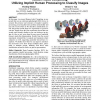Free Online Productivity Tools
i2Speak
i2Symbol
i2OCR
iTex2Img
iWeb2Print
iWeb2Shot
i2Type
iPdf2Split
iPdf2Merge
i2Bopomofo
i2Arabic
i2Style
i2Image
i2PDF
iLatex2Rtf
Sci2ools
CHI
2008
ACM
2008
ACM
Human-aided computing: utilizing implicit human processing to classify images
In this paper, we present Human-Aided Computing, an approach that uses an electroencephalograph (EEG) device to measure the presence and outcomes of implicit cognitive processing, processing that users perform automatically and may not even be aware of. We describe a classification system and present results from two experiments as proof-ofconcept. Results from the first experiment showed that our system could classify whether a user was looking at an image of a face or not, even when the user was not explicitly trying to make this determination. Results from the second experiment extended this to animals and inanimate object categories as well, suggesting generality beyond face recognition. We further show that we can improve classification accuracies if we show images multiple times, potentially to multiple people, attaining well above 90% classification accuracies with even just ten presentations.
CHI 2008 | Classification Accuracies | Human Computer Interaction | Implicit Cognitive Processing | Inanimate Object Categories |
| Added | 30 Nov 2009 |
| Updated | 30 Nov 2009 |
| Type | Conference |
| Year | 2008 |
| Where | CHI |
| Authors | Pradeep Shenoy, Desney S. Tan |
Comments (0)

